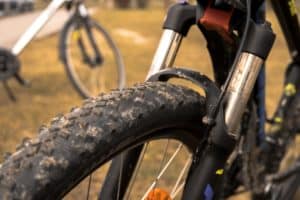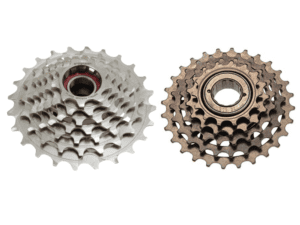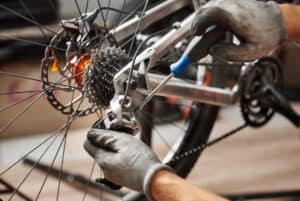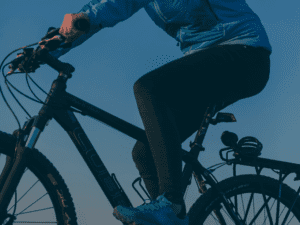In this article, I’ll guide you on how to buy used mountain bikes so you get the best bang for your buck. I’ll also share tips on what to look to save you on maintenance and replacement costs.
So let’s jump into it.
How To Buy Used Mountain Bikes – Complete Guide
Step 1: Research and Browse the Internet
Do you want a used mountain bike? There are a couple of places to check. eBay, Craigslist, Facebook Marketplace, and any reputable bike shop in your town have been helpful not just for me but for millions of other cyclists.
Your friends may also give you leads to some deals they know of. But before getting the bike, imagine!
You don’t want to buy just any bike, and you have your favorite bike model in mind. Imagine how you want it, the components, brand, etc. In fact, what model do you desire, and what features are you looking at?
Then there’s the size of the bike to consider. It’s crucial not to get a bike that is too short or long for you.
Bike sizing differs between brands though they don’t vary that much. You also have the option of picking up the bike to determine if it fits you.
Let’s assume you have found the models you like. Find out whether the bike model has ever been recalled for some frame issues and what model year it was exactly.
Also, find out any unignorable updates or changes, such as the geometry changes. I’ve noted that the drive train and the internal cabling have been changing for many bikes.
Both high-end, and budget full suspension bikes sometimes come with a different and better rear suspension technology.
Armed with all the information about the bike you want, it’s time to browse the net. Don’t take the first offer yet. Browse the web, check sites such as eBay, and chat with different sellers until you get the best deal.
Step 2: Ask Questions and Score a Deal
You have to be curious about the bike you are about to buy. It could be stolen or a knock-off, so try to get as many answers as you can from the seller.
These are the most important questions you should ask.
- Why are you selling the bike? Are you moving out, it’s because of an emergency, or you are looking to upgrade?
- Where did you buy the bike? Online or from a shop? When was that?
- Are you the first owner? Did you buy from someone else?
- How many miles on it? How often do you ride it? Where do you mostly ride it?
- What’s your maintenance procedure? Done frequently? How often do you clean your bike? What washing tools and lube do you use for the bike?
- Have any of the bike’s components been replaced? If it’s the tires and the drivetrain, how old are they since replacing them?
- Is the bike working perfectly? Which parts have issues, and are they available in the market?
- What’s the bike size? How long is the seat post? How wide are the bars?
Tires and the drivetrain are likely the first components of the bike to wear out after 2,000 miles or around there. These should be your main concern.
The tires are replaceable and not as expensive. However, when it comes to the drivetrain, it can be costly.
You might need to buy a chainring, a whole cassette, and chain, and also the jockey wheels for the derailleur, which will collectively cost you over $200. This is important to know so that you can score a bargain.
However, it’s the bike size that should get you from your couch. If the bike is not the perfect size, it’s not worth driving across town or to another city to check it.
Check your height against the recommended bike size on the bike charts available online. One thing I’m sure of is that a bike bigger than the recommended size, for instance, an XL bike when your recommended size is Large, will work just as fine since you can lower the seat post.
Never buy anything used at the price the owner quoted, no matter how mint it looks. Unless it’s on a site where discounts can’t be offered, try to bargain.
Don’t feel selfish about it but consider you’ll need to make replacements sooner or later. Also, it’s advisable to buy a bike that gives you value for your money.
Besides, what matters is that you feel good after the purchase, but for now, hold your horses.
Once you agree, don’t send the total amount yet. Yes, you can send half the amount to reserve the bike, but it should be refundable if it happens you don’t like the bike. Sites like eBay offer buyer’s protection, though.
Step 3: Go and Inspect the Bike
A bike may look good in the pics, people are pro photographers out there, and the pictures might deceive you.
Maybe what you saw were stock photos by bike manufacturers. You have probably seen the memes of people ordering dresses on some e-markets only for them to get curtains or rugs out of the box.
Hilarious! Isn’t it? It’s always advisable to see the bike you intend to buy with your own eyes. Pass by the gas station and fill your tank because you are going to going to find “the apple of your eye.”
What to Check in Old Mountain Bikes
- The frame
- Cockpit & contact points
- Brakes
- Drivetrain
- Tires
- Wheels
- Suspension
Let’s break it down
The Frame
The most crucial part of every bike is the frame. The condition of the frame and size is more important than anything else on the bike. A few cosmetic marks are okay, but if there are many, it indicates careless handling by the owner.
If it’s a carbon bike frame, find whether the frame has cracked before. If the frame is in the best condition, it’s proof that the bike has been taken care of well. Check the paint job and the welds. If there’s no visible damage, then it means the bike is okay.
Cockpit & Contact Points
Leaning the bike against the wall damages the grips and the saddle. Also, in case of a crash, the cockpit and the contact points are the most impacted.
If the bike doesn’t come with its original components such as the bars, stem, grips, brakes, shifters, and saddle, it could be a result of a crash that damaged the parts or the owner upgraded for their own reasons.
When inspecting a bike, visually check the bars, stem, grips, and saddle, touch, and hold them. Get a bargain while considering the conditions of these parts.
You may want to upgrade the parts according to your preferences and sell those that were there before. It would be refreshing to know they are in good condition, and you can swap them up for the components that you want.
Brakes
Looking at the brakes will not give a detailed report of their condition unless you take a short spin. There are other things also to consider, like the type of brakes the bike comes with.
If they are mechanical disk brakes, then look for a bike with hydraulic disk brakes. They come in different types, Tekro being the most affordable, so a bike with a Tektro hydraulic system should be cheaper.
Pull the brake levers. Do they go right past the grips? That’s an indication that you need to bleed the brakes and fill them with fresh mineral oil.
The brake pads and rotors get the most punishment and intense pressure, especially when riding downhill. Have the owner take out the calipers and assess the damage it has suffered.
Drivetrain
If your bike has a knackered drivetrain, I’m afraid all your attempts to enjoy riding will be futile. A damaged chain, especially, will damage everything else from your chainrings to your cassette, which will mean extra cost.
Check whether the rollers on the chain are too loose. If they are, then the chain has expanded and signed out. You’ll need to replace it.
The worn-out chain will also give you a rough idea of the life remaining in the cassette and the chainrings. Check the teeth.
Are they sharp on the edge? Replace that! Does the mech(derailleur)have scratches or cranky? It was probably impacted by a crash.
If the shifter is damaged, then that too was affected by a collision. A broken hanger indicates that the crash may have been so severe.
Tires
The tires are no big issue. In fact, that’s the part of the bike that should never worry you at all. But they should be put into consideration when bargaining for the bike.
Pretty worn-out tires mean you should get a discount as you might need to buy new tires soon.
There’s also the issue of having the right tires for the job.
What’s the brand of the tires? Maxxis, Schwalbe, Kenda, Vittoria, Bontrager, WTB? If they are Maxxis, are they Minion, Ardent, or Ikon? These are a few more questions to answer.
Wheels
Before making the big transfer, assess the wheels. Wheel sizes should be a concern too. 29” wheels are the norm now, and 27.5” wheels are pretty too common as well.
But I would recommend a 29er unless your riding style is dirt jumping. Are the spokes loose, and are the nipples worn out? Are the hubs serviced and running silent and with some cracking sound?
It’s also vital to check if the bike is running true. Put your finger on the chainstay slightly close to the rim edge.
Spin the wheel slowly and see whether the rim is moving from side to side. If it’s not regular, then nothing much to worry about, as the bike mechanic can fix that.
Suspension
The suspension system consists of the fork and the rear shock. If you are buying a hardtail bike, then you only have the fork to be concerned about.
The most popular fork brands are RockShox and FOX, then Suntour is available on budget bikes. Other available options include Marzocchi and Manitou, which are not that common.
These brands also manufacture rear shocks, which you can find on full suspension bikes.
If the forks or the rear shock need attention, then set aside a hundred bucks for that. Check signs of wear on the stanchions, bushings, loose bolts, and any signs of wear on the sides of the forks.
Hold the bars tight for the fork, hold the front brakes, and observe if they are tight. For the rear shock, hold the rear wheel down and lift the bike by the frame.
If you hear any creaks or abnormal movement, those are signs that the bike’s suspension system is not in its best health.
If you get to test-ride the bike, run it over a technical area and listen to the responsiveness of the suspension. Does it rebound? If you buy a bike with a bad suspension, you’ll be screwed for real.
Step 4: Ask for the Documents for Verification
When buying a used bike, many questions linger. For example, is the bike stolen? Is it an original model or an imitation? Is the seller reliable?
Those are some of the questions you need answers to. One of the ways to tell whether a bike may have been stolen is when the seller sells the bike at a very low price.
The actual owner of the bike knows the value and wouldn’t sell it at a throwaway price.
Another sign is when the details of the bike are listed incorrectly. The seller can’t describe the bike and the components and has no riding experiences they would be happy to tell.
Ask for the original purchase receipt and check it against the frame number of the bike. The frame number is situated just under the frame near the BB tube.
Also, do a quick search of the number on the national database and see if it’s been reported.
Also, be careful not to buy a knockoff. Some manufacturers in China have zero regard for copyrights and have been imitating other brands and releasing them to the global market.
The biggest victims of these alterations are Pinarello and Look. Trek and Santa Cruz MTBs too. Be careful not to buy a fake bike.
One of the ways to tell if the frame is fake is an oversize headtube, heavier material, and awkward color schemes.
Lastly, on verification, confirm whether the seller is reliable. In fact, you should verify before going picking up the bike, that’s if you met the seller on eBay.
The site provides you with the seller’s history as well as feedback from other buyers. I always prefer buying a used bike from a reputable shop as it’s more transparent with its dealings.
Step 5: Test Riding, Buying the Bike, and Transfer of Ownership
Eyes can be deceiving. Get your ass on the saddle and ride the bike in person. The seller won’t mind letting you take a spin around the neighborhood or on the trails near their home, provided you leave your car keys behind.
A spin will either fulfill the burning desire of riding a bike or help you discover all the complications in the bike.
You better hope that the bike will be great overall. A bike with minor or no issues will let you ride it for quite some time before you get to replace it.
The next part is bargaining and getting the best price for the bike. If you already paid via eBay, the owner will not be giving you any discount.
However, if you met the seller on other classified sites, you probably want to ask for a discount based on the bike’s condition.
Some parts may need replacement or attention. Once you agree on the bike price, please transfer money to their account.
The importance of doing this is to leave a trail, in case it turns out that the deal was not good and the bike was stolen.
The seller should transfer the ownership to you in the form of documents and an agreement. You don’t want to be accused of handling stolen property or a property you can’t prove to be the owner.
The document should state that the bike has been transferred from a so and so, with their ID details and signature indicated, and your name, ID number, and signature provided.
The bike’s model number should also be on the agreement. Leave one copy of the agreement with the seller and take yours with you.
Also Read: How to Build Your Own Mountain Bike (just in case you decide against buying a used mountain bike).
Final Remarks On Buying a Used MTB
You have finally acquired a bike. Congratulations on that big milestone. Pack the bike in a box and put it safely on the rear of your van.
When you get home, have a mechanic examine it and do all the necessary repairs and maintenance.
Get your bike in good order and enjoy riding in bike parks and rough terrain. We are always a few letters on the keyboard away, ready to help.





